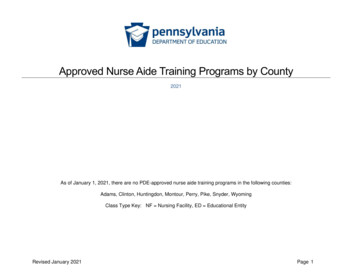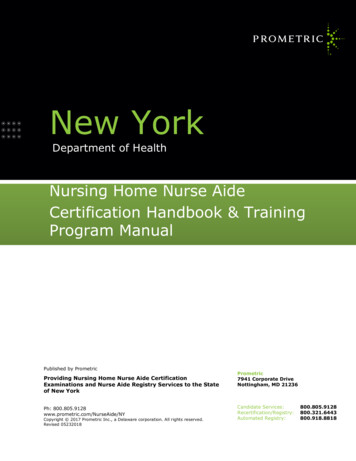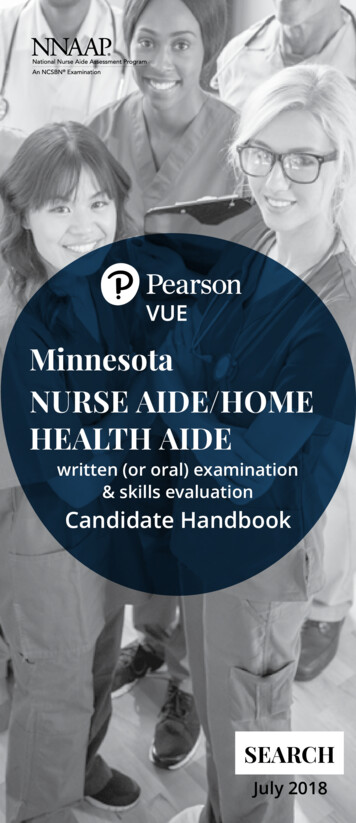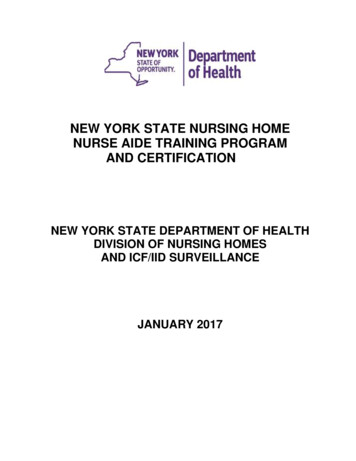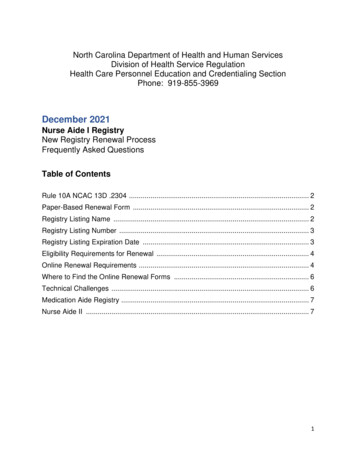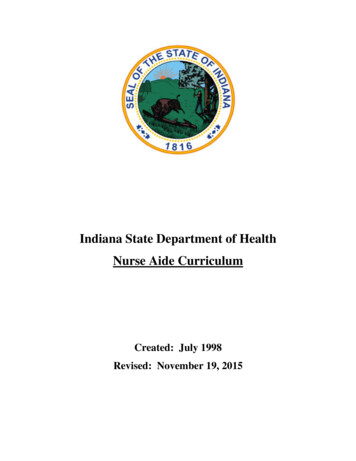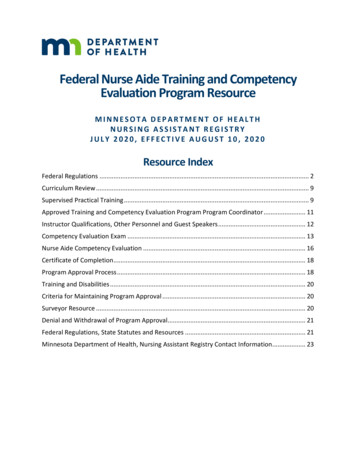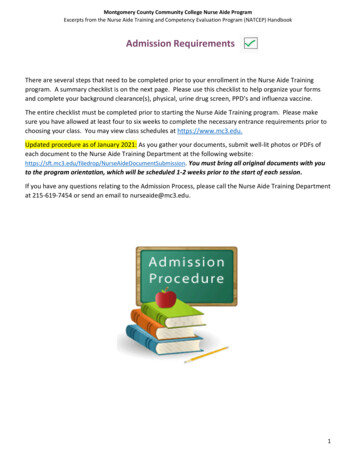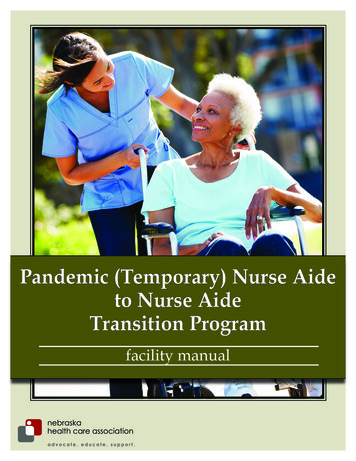
Transcription
Department of Medical Assistance ServicesPersonal Care Aide TrainingCurriculum2003
The Department of Medical Assistance ServicesPERSONAL CARE AIDE CURRICULUMForewordThe Virginia Department of Medical Assistance Services (DMAS) allowsprovider agencies to develop a Personal Care Aide (PCA) training program within theiragency. The purpose is to assist providers in recruiting, effectively training, and retainingnursing aides to provide services to Medicaid Waiver recipients.DMAS has developed this curriculum to be used by providers who desire to havea PCA training program within their agency. In the past Medicaid required providers tosubmit a copy of their PCA training curriculum to the Long Term Care and QualityAssurance Division of DMAS for approval.Beginning July 1, 2002, all agencies that have not previously received a letter ofapproval and authorization must use this curriculum as a part of their training program.The provider must complete and submit the Request for Authorization form (DMAS-260)and receive a letter of authorization from the Waiver Services Unit (WSU) at DMAS, anduse this curriculum as a part of their program. All authorized programs will be added tothe list of Medicaid approved PCA training programs. This list is regularly updated andposted on the DMAS web site.The DMAS Personal Care Aide training program must give a minimum of 40hours of nursing aide training and be supervised and taught by a RN who is currentlylicensed to practice in the Commonwealth of Virginia. The RN must have at least two(2) years of related clinical experience as a Registered Nurse or as a Licensed PracticalNurse (LPN). Clinical experience may include work in an acute care hospital, publichealth clinic, home health agency, or nursing facility.Graduates of this PCA program are only authorized to provide personal carenursing aide services to Medicaid Waiver recipients. All students must understand thatthis program will not be recognized by the Virginia State Board of Nursing, nursing andmedical facilities, or other state nursing boards, but only by DMAS Waiver programs.The personal care aide training class may include any number of students;however there must be a ratio of one (1) instructor to every ten (10) students. Thepurpose is to ensure adequate training and instruction for each student.This aide training curriculum is not intended to include all information andpractical training that is appropriate for personal care nursing aides. This outlinedcurriculum is information that DMAS is requiring as a part of the training program.DMAS created this curriculum to ensure that certain issues and subjects are taught tostudents who will be providing Medicaid services. All techniques, procedures, tasks, andassigned duties within this curriculum should be demonstrated and observed by thetrainer prior to assigning the nursing aide to an independent setting such as a recipient’sPage 2 of 34
The Department of Medical Assistance ServicesPERSONAL CARE AIDE CURRICULUMhome. The Appendix includes a skills check list and a test to be used at the end of thetraining. These documents can be altered to include any specific requirements of alocality or training area.DMAS suggests contacting other resources to assist with the training, such as thepolice and fire department to put on in-services for the students in areas of safety. Thereare aspects of caring for a recipient in the community that the aides may not be aware of,such as how to remove a bed-bound recipient from the home in the case of a fire. Thetrainer may want to include some education on Hospice, death and dying, or any othertopics that would assist the aide in providing quality care to the recipient.If you have any questions, concerns, or would like assistance with thiscurriculum, please contact the Waiver Services Unit at (804) 786-1465.Waiver Services UnitLong Term Care andQuality Assurance DivisionPage 3 of
The Department of Medical Assistance ServicesPERSONAL CARE AIDE CURRICULUMForewordI.IntroductionA. DMAS ExpectationsB. DMAS Requirements for Personal Care AidesII.The ElderlyA. Physical and Biological Aspects of AgingB. Psychological Aspects of AgingC. Physical and Emotional Needs of the ElderlyD. Critical Situations that the Personal/Respite Care Aide may beInvolvedE. Orientation to Types of Physical Disabilities of HandicapsIII.Personal Care and Rehabilitative ServicesA. Body MechanicsB. Limitations on the Personal/Respite Care Aide ActivitiesC. Techniques used by Personal/Respite Care AideD. Goals of Personal CareE. Prevention of Skin BreakdownF. Vital SignsVI.Home ManagementA. Care of the Home and Personal BelongingsVII. Safety and Accident Prevention in the HomeA. Common Types of AccidentsB. Accident PreventionC. Typical Hazards in the Ho meD. Ways to safety-Proof the HomeE. Policies and Procedures Regarding Accidents or InjuriesVIII. Food, Nutrition, and Meal PreparationA. Importance of Nutrition to the IndividualB. General Concept of Planning MealsC. Special Considerations of Normal DietD. Special Considerations in Preparation of Special DietsE. Food Purchasing and PreparationF. Food Storage and SanitationIX.Documentation Requirements for Medicaid RecipientsAide RecordsProvider Agency Plan of CareBibliographyAppendixSkills Check ListDefinitionsFinal TestSample Certificate of CompletionPage 4 of 23242527Attached
The Department of Medical Assistance ServicesPERSONAL CARE AIDE CURRICULUMI.IntroductionA. This program has been developed by the Department of Medical AssistanceServices (DMAS) to establish a uniform training curriculum. Its purpose is totrain and teach qualified persons to provide personal care services underMedicaid Waivers. DMAS hopes that this program will assist in recruitingand retaining qualified personal care aides.B. DMAS Requirements for Personal Care Aides (PCA) include:1. Must be 18 years of age or older;2. Must be able to read and write in English to the degree necessary toperform the tasks expected; and3. Must be able to perform the tasks required.II.The ElderlyA. Physical and Biological Aspects of Aging1. Cardiovascular changes:a. The heart rate slows, causing a slower pulse and less efficientcirculation1b. Blood vessels lose elasticity and develop calcium deposits, resulting innarrowing1c. Blood pressure increases because of changes to the walls of the bloodvessels1d. It takes longer for the heart rate to return to normal after exercise1e. Veins become enlarged, causing the blood vessels near the surface ofthe skin to become more prominent.12. Respiratory Changes:a. Lung capacity is decreased because of muscular rigidity in the lungs2b. Cough becomes less effective, allowing pooling of secretions and fluid2in the lungs, increasing the risk of infection2c. Shortness of breath may occur on exertion2d. Less effective gas exchange takes place in the lungs23. Urinary System Changes:a. Bladder capacity decreases, increasing the frequency of urination3b. Kidney function increases at rest, causing the elderly to get up duringthe night to urinate3Pageof 3434Page 15 of
The Department of Medical Assistance ServicesPERSONAL CARE AIDE CURRICULUMc. Bladder muscles weaken, causing leaking of urine or inadequateemptying of the bladder3d. The prostate gland (found in men) frequently enlarges, increasing thefrequency of urination and causing dribbling, urinary obstruction, andurinary retention34. Digestive System Changes:a. Saliva production in the mouth decreases, interfering with digestion ofstarch4b. Taste buds on the tongue decrease, beginning with sweet and salt4c. The gag reflex in the throat is less effective, increasing the risk ofchoking4d. Movement of food into the stomach through the esophagus is slower4e. The stomach takes longer to empty into the small intestine, so foodremains there longer4f. Fewer digestive enzymes are present in the stomach, causingindigestion and slower absorption of fat45. Nervous System Changes:a. More time is needed for tasks involving speed, balance, coordination,and fine motor activities, such as those involving fingers5b. Problems develop with balance and coordination as a result ofdeterioration of the nerve terminals that provide information to thebrain on the movement and position of the body5c. The lens in the eye becomes less flexible, causing visual changes5d. Decreased secretion of fluid in the eye causes dryness and itching5e. Nerves and blood supply to the ears decrease, causing a difficultyhearing5f. There is a decrease in the ability to feel pressure and temperature,resulting in a higher potential for injury5g. Blood flow to the brain decreases, which may result in mentalconfusion and memory loss56. Musculoskeletal Changes:a. A decrease in strength, endurance, muscle tone, and reaction time iscaused by loss of elasticity of muscles, and decrease in muscle mass6b. Bones lose minerals, become brittle, and break more easily6c. The spine is less stable, less flexible, and more easily injured6Page26ofof3434Page
The Department of Medical Assistance ServicesPERSONAL CARE AIDE CURRICULUMd. Posture may become poor because of weakness in back muscles6e. Degenerative changes, or deterioration, occur in the joints, resultingin limited movement, stiffness, and pain67. Integumentary (Skin) Changes:a. The skin thins and becomes less elastic; wrinkles appear, and the skinbecomes irritated and breaks more easily7b. Blood vessels that nourish the skin become more fragile and breakmore easily, resulting in bruising, senile purpura, and skin tears7c. Blood flow in vessels that nourish the skin is reduced resulting inslower healing7d. Oil glands that supply the skin secrete less, causing drying of the skinand itching7e. Perspiration decreases, and the body’s ability to regulate temperatureis impaired7f. Subcutaneous fat diminishes7g. Blood supply to the feet and legs is diminished7h. Fingernail and toenail growth slows and nails become brittle7i. Hair thins and turns gray78. Endocrine System Changes:a. Blood sugar level increases because of delayed release of insulin, ahormone that regulates sugar use in the body9b. The amount of calories needed for the body to function normallydecreases because of a lower metabolism rate, or slower bodyfunction99. Reproductive System Changes:a. Hormone production decreases, causing decreased size of testes, anda lower sperm count9b. More time is needed for an erection to occur9c. Fewer female hormones are produced9d. The vagina becomes shorter and narrower9e. Vaginal secretions decrease9f. Breast tissue decreases and the muscles supporting the breastsweaken9Page 37ofof3434Page
The Department of Medical Assistance ServicesPERSONAL CARE AIDE CURRICULUMB. Psychological Aspects of Aging1. There are many factors that contribute to the psychological aspects ofaging. These include, loss of income, loss of home, loss of independence,loss of spouse, illness or disease, loss of sense of security, and the loss oftrust.2. There are numerous behaviors due to psychological factors. These include,poor appetite, depression, anger, and insomnia.C. Physical and Emotional Needs of the Elderly1. Basic Human Needs:a. Physiological needs-food, water, sleep, rest, physical activity,elimination, and oxygen10b. Safety and security-safe and protected from harm in the environment 10c. Personal security in his or her family, relationships, and job.Financial security10d. Love and belonging-give love and receive love from others. Showrecipient you care and accept him or her, regardless of disability,condition, appearance, or behavior. Provide privacy during care,treatments, and procedures, and respect the recipient’s dignity10e. Self-esteem and respect-feel important and worthwhile; self-imagemay be threatened which may result in the recipient complainingfrequently. The threat to self-esteem may result in recipient reactingwith anger10f. Self-actualization-feeling a sense of accomplishment and success10D. Critical Situations that the Personal/Respite Care Aide may be Involved1. Verbally abusive – The PCA is in the home to give care, support, andunderstanding. He/she would not be in the home if the recipient did notneed professional medical assistance. The PCA must always maintainprofessionalism, and never verbally attack the recipient.2. Combative - The PCA is never, under any circumstances, to hit arecipient. Usually, if you leave the recipient alone for a few minutes andthen return and greet him/her, as if it were the first time you had seenhim/her that day, he/she may have calmed down.3. Emergency - The PCA must be aware at all times of the recipient and whatis happening with him/her. The recipient may stop breathing, have a heartattack, stroke, a diabetic complication, or other physical or psychologicalemergency. The PCA must be prepared with a plan of action in case of anemergency. Depending on the problem, the PCA should know when it isPage46ofof3434Page
The Department of Medical Assistance ServicesPERSONAL CARE AIDE CURRICULUMappropriate to call 911, the recipient’s physician, a family member, and/orthe personal care agency.E. Orientation to Types of Physical Disabilities or HandicapsThe aide may encounter the following:1. Rheumatoid Arthritis – This is a severely crippling and painful disease.Patience and gentleness must be used when moving, turning, bathing, ordressing the recipient;2. Stroke – This may result in slurred speech, difficulty swallowing, paralysisin one extremity, paralysis on one side of the body, or total paralysis. ThePCA needs to ensure skill of transfers and, if necessary, the use of a Lift;3. Heart trouble – The recipient may show signs of chest pain on exertion,sweating, nausea, pain in the left arm, jaw, shoulder blade, and maybecome short of breath easily; and4. Alzheimer’s – This can manifest in a variety of ways. Many people withAlzheimer’s may wander off, and therefore will need to be monitored atall times. They may present a danger to themselves and others byattempting to perform tasks and then forgetting what they were doing. Oneexample is in the attempt to cook, and the stove is left on. Recipients withAlzheimer’s may also be combative at times and not be aware of theiractions.III.Personal Care and Rehabilitative ServicesA. Body Mechanics1. Use of proper body mechanics by the personal care aide will preventinjury to the PCA and the recipient, and utilize the safest and often theeasiest way to move/transfer the recipient.2. Limitations on the personal care aide to activities - The aide should alwaysbe aware of any skilled needs of the recipient, which may have an impacton positioning. The PCA should also be aware of any restrictions on therecipient’s activity and functioning ability.3. Techniques of body mechanics (Demonstration of these techniques isnecessary for proper training.)a. Helping the recipient sit up in bed - Make sure the bed is in its lowestposition. If it is a manual bed, squat down to reach the handle, do notbend over. If the recipient is in his/her own bed, rather than a hospitalbed, the recipient should be close enough to comfortably reach thebed. It may be necessary to position yourself on the bed with therecipient to maintain proper body alignment.Page 57ofof3434Page
The Department of Medical Assistance ServicesPERSONAL CARE AIDE CURRICULUMb. Moving the recipient in bed - This may be achieved by having therecipient logroll from side to side.c. Helping the recipient move from:i.Bed to chair and return - If this is a pivot transfer, the PCA mustensure the chair is positioned close to the bed. The recipientshould have secure fitting shoes or slippers on for transfers. ThePCA will position himself/herself in front of the recipient, placehis/her feet against the toes of the recipient, put his/her armsunder the recipients arms, place one knee in front of therecipient’s knee and stand straight up, holding on to the recipientat all times.ii.Bed to wheelchair and return - The PCA must ensure thewheelchair is in the correct position with the wheels locked inplace. Make sure the wheelchair is positioned so the recipient’sfeet will not become entangled in the footrests. If footrests aremovable, fold them up and out of the way.iii.Bed to toilet/commode and return - The PCA should ensure thebedside commode is properly positioned beside the bed to allowthe recipient to transfer with minimal exertion.iv.Bed to tub/shower and return – The PCA should ensure therecipient is wearing secure fitting shoes or slippers. Assist therecipient to a sitting position on the side of the bed. Assist therecipient as needed to a standing position; offer stand-byassistance to the bathroom.v.Chair to commode and return - Ensure the recipient is wearingsecure fitting shoes or slippers. Assist the recipient to a standingposition; provide stand-by assistance to the bathroom.vi.Chair to tub and return - Ensure the recipient is wearing securefitting shoes or slippers. Assist the recipient to a standingposition. Provide stand-by assistance to the bathroom. Assistthe recipient to disrobe and stepping into the tub.vii. Wheelchair to tub and return - Ensure the recipient is wearingsecure fitting shoes or slippers. Roll the wheelchair into thebathroom and lock the wheels. Assist the recipient to a standingposition. Assist the recipient in disrobing, and stepping into thetub.viii.Wheelchair to commode and return - Ensure the recipient iswearing secure fitting shoes or slippers. Roll the wheelchair intothe bathroom and lock the wheels. Assist the recipient to astanding position. Assist the recipient in pulling down his/herunderpants, and help him/her to sit safely on the commode.Page66ofof3434Page
The Department of Medical Assistance ServicesPERSONAL CARE AIDE CURRICULUMd. Helping the recipient walk with a walker, crutches, or a cane walker Ensure the recipient is wearing secure fitting shoes or slippers. Placethe walker in front of the recipient, and then place the recipient’shands on the walker. Scoot the recipient to the edge of their seat andassist him/her to a standing position.e. Crutches - Ensure the recipient is wearing secure fitting shoes orslippers. Place the crutches in front of the recipient. Have the recipientplace his/her hand on the handle of the crutches and assist the recipientto a standing position.f. Cane - Ensure the recipient is wearing secure fitting shoes or slippers.Assist the recipient in scooting to the edge of his/her seat. Place thecane in his/her strong hand.B. Limitations on the Personal/Respite Care Aide’s Activities - There are sometasks that are never to be performed by the PCA. These tasks include, but arenot limited to, the following;1. A PCA may not perform a skilled nursing task, such as changing acatheter, giving an injection, changing a sterile dressing, performing anytype of tube feeding, suctioning, or cutting finger and toe nails.2. A PCA may not provide care for other persons residing in the samehome. The PCA is only to provide services to the Medicaid recipient(s).3. The PCA must understand there are limitations to the activities that areallowed within the area of his/her expertise. If the PCA does not followthese guidelines, he/she risks causing injury to the recipient.C. Techniques used by Personal/Respite Care Aides - The instructor is to providea demonstration for each procedure and then have each student demonstratethe procedure.The PCA must observe Universal Precautions at all times. Washing handsbefore and after each procedure is necessary, and if possible, wash handsduring the procedure. Whenever there is a possibility of coming into cont actwith blood or bodily fluids, you must wear gloves. The PCA should removethe gloves in the correct manner (A demonstration should be given by theinstructor) to prevent contamination, and wash his/her hands immediately withsoap and water. The most effective way to prevent the spread of infection isby washing your hands.1. Assisting the recipient with eating – Before feeding the recipient, ensuretoileting needs are met, and all equipment used for personal care activitiesis removed from view. Make sure the recipient is in a safe and comfortableposition to eat. Explain the procedure to the recipient.a. Sit at or below the recipient’s eye level, if possible.b. Check the food temperature before feeding.11Page 77ofof3434Page
The Department of Medical Assistance ServicesPERSONAL CARE AIDE CURRICULUMc. Tell the recipient what the meal consists of.11d. Recipient may be able to eat with his/her fingers.11a. Offer liquids at intervals.11b. Make pleasant conversation while feeding.11c. Avoid rushing the recipient.11d. Be emotionally sensitive to the recipient’s needs.112. Assisting the recipient with dressing – Before dressing the recipient, askwhat he/she would like to wear. Prepare all needed articles and have themwithin reach. Ensure the recipient is in a safe and comfortable position.Explain the procedure to the recipient before dressing him/her so that therecipient knows what you are going to do.a. Provide privacy and avoid exposing the recipient.12b. Wear gloves and apply principles of universal precautions if youanticipate contact with blood, body fluids (except sweat), secretions,excretions, mucous membranes, or non-intact skin.12c. Check the plan of care for special instructions and use of adaptiveequipment.12d. Encourage the recipient to do as much self care as possible.12e. Clothing should be appropriate for age, and season, and colorcoordinated. Do not put torn clothes on recipient.12f. If the recipient has one paralyzed or weak side, remove the clothingfrom the strong side first. Put clothing on the weak side first. Alwayssupport the weak or paralyzed extremity.12g. It is easier to dress recipients who can assist if they are standing orsitting.12h. It is easier to dress a dependent recipient in bed.12i. Recipients who are dressed in street clothes should wear properundergarments.12j. When dressing a recipient with catheters or tubes, treat them as partof the recipient’s body. Avoid pulling on them or obstructing them. Donot disconnect them. Avoid elevating the urinary catheter above thelevel of the bladder during the dressing procedure.12k. Gather the pant legs and sleeves before putting them on therecipient.123. Mouth care – Ensure the recipient is in a safe and comfortable position.Explain the procedure to the recipient.Page86ofof3434Page
The Department of Medical Assistance ServicesPERSONAL CARE AIDE CURRICULUMa. Gather all needed equipment.b. Encourage the recipient to do as much self care as possible.13c. Allow the recipient to brush his/her own teeth. Take the recipient tothe bathroom sink if possible.13d. Always wear gloves when performing oral hygiene. Avoidcontaminating environmental surfaces and clean supplies with yourgloves.13e. Observe and report any signs of irritation, sores, loose teeth, pain,swelling, or other abnormalities to the RN supervisor.13f. Handle dentures carefully.13g. Let the recipient remove the dentures from the mouth if able.13h. Check the dentures for cracks, chips, or loose teeth.13i. Store dentures in a marked denture cup. Some dentures are stored dryand others are stored wet.134. Hair care – Allow the recipient to assist with hair care, as he/she is able.Explain the procedure to the recipient.a. Assist the recipient with shampooing, drying, and styling the hair asneeded.b. The PCA should not cut or perm the recipient’s hair.c. Use caution when using any type of heated device to style or dry hair.5. Shaving male patients – Allow the recipient to assist, as he/she is able.Gather all needed equipment, and explain the procedure to the recipient.a. It is preferable that an electric razor is used when shaving therecipient.b. The provider agency should ensure the PCA is competent to use adisposable razor with minimal injury to the recipient.6. Bathing (tub, shower, bed) – It is important to provide privacy for therecipient. Gather all necessary equipment and explain the procedure to therecipient. If the recipient has an indwelling catheter, washing around theurethra is considered part of the bath. If the recipient has a condomcatheter, the PCA should remove the catheter, cleanse the penis and applya new condom catheter following appropriate procedure. Instruction andreturn demonstration should be given in this procedure.a. Consult the plan of care for the type of bath to be given, specialinformation, recipient’s self-care ability, routines, use of adaptivedevices, recipient needs.15Page 97ofof3434Page
The Department of Medical Assistance ServicesPERSONAL CARE AIDE CURRICULUMb. Gloves are worn for part of the bathing procedure. You will have towash your hands and change your gloves several times during theprocedure to maintain universal precautions.15c. If you have open cuts or sores on your hands, you will have to weargloves for the entire bathing process.15d. Moving the recipient to the side of the bed near you may be helpful.15e. Be sure the room is warm and comfortable.15f. Keep the recipient’s body covered with a towel or blanket for modestyand warmth. Expose only one part of the body at a time.15g. Change the water if it cools off or becomes soapy or dirty.15h. Soap can be irritating or drying to the skin. Be sure it is rinsed off.157. Beds (making with and without the recipient in the bed) – Begin bygathering all needed supplies, and then explain the procedure to therecipient.a. Have the recipient turn to one side of the bed. Ensure the rails are up,if applicable, or that the recipient is not in danger of falling.b. Remove the linens from one side of the bed. Roll them under therecipient’s back.c. Apply the clean linens to the same side, and roll them under the dirtylinens.d. Assist the recipient to turn to the other side. Again, ens ure the recipientis safe.e. Pull the dirty linens out from under the recipient’s back, pull the cleanlinens out, and straighten the linens out as needed.8. Elimination – Depending on the physical abilities of the recipient thisfunction may require the use of a bedpan, bedside commode, or going tothe bathroom. Always ensure privacy for the recipient. Help the recipientwash his/her hands after he/she is finished.a. Bedpani.If the recipient uses the bedpan, have the recipient roll over toone side. Apply a minimal amount of powder to the bedpan,which will prevent the recipient’s skin from sticking to thebedpan. Place the bedpan against the recipient’s buttocks andhold it in place while assisting the recipient to turn over on to thebedpan.ii.When the recipient is finished using the bedpan, have therecipient turn over on their side again, while holding on to thebedpan to prevent spillage.Page106 ofPageof 3434
The Department of Medical Assistance ServicesPERSONAL CARE AIDE CURRICULUMiii.If the recipient is able to wipe himself/herself, give some toilettissue to do so. If the recipient is unable to wipe himself/herselfoff, put your gloves on and wipe the recipient as needed. Ifnecessary, use a warm washcloth and mild soap.iv.Ensure that the recipient is safe and comfortable, then remove thebedpan and clean it thoroughly.b. Urinali.If the male recipient needs to use the urinal, the PCA shouldwash his/her hands first, and then put gloves on.ii.Explain the procedure to the recipient.iii.Provide privacy for the recipientiv.If he is able to properly place it, hand the urinal to the recipient.If the recipient requires assistance with the urinal, place itbetween his legs, and place his penis inside of the urinal.v.Provide him some privacy, and return in a minute or two to see ifhe has finished.vi.Assist the recipient with cleaning himself off as needed.vii.Record the amount in the urinal if the output is being tracked.viii.Report to the RN supervisor any complaints of burning, itching,urgency, or hesitancy by the recipient.c. Bedside commodei.Always ensure privacy for the recipient.ii.Assist the recipient to sit on the side of the bed to get his/herbearings and balance.iii.Place secure fitting slippers or shoes on his/her feet.iv.Assist to a standing position and transfer to the bedsidecommode.v.When the recipient has finished, help the recipient to wipehimself/herself off.vi.Remove the container from the bedside commode and clean itthoroughly.d. Toileti.Ensure privacy for the recipient.ii.Help the recipient put secure fitting shoes or slippers on.Page 117 ofPageof 3434
The Department of Medical Assistance ServicesPERSONAL CARE AIDE CURRICULUMiii.Assist the recipient to sit on the edge of the bed to get theirbearings and balance.iv.Assist the recipient to a standing position, and ambulate to thebathroom.v.When the recipient has finished, help him/her wipe off.vi.Assist the recipient with washing his/her hands.e. Back rub - the recipient should be lying on his/her side in a safe andcomfortable position. Wash your hands, and explain the procedure tothe recipient.i.Apply lotion to your hands and rub your hands together to warmthe lotion.ii.Apply the lotion to the recipient’s back, rubbing a long circularmotion.iii.Observe the back and hip areas for any signs of redness orbreakdown. Report any changes to the RN.D. Goals of Personal Care1. Promote self-care and independence - Allow the recipient to perform asmuch of his/her care as possible.2. Assure safety and comfort - Always make sure the recipient is safe and notat risk of injury.3. Maintain dignity and self-respect - Provide privacy during all procedures.4. Maintain stability.E. Prevention of Skin Breakdown - The recipient is dependent on the PCA toeither assist with activities of daily living or perform the tasks for therecipient.1. The tasks are important for several reasons:a. It provides the aide an opportunity to inspect the recipient’s skin. ThePCA should ensure the recipient has no red marks, bruising, bedsores,or skin tears that need to be reported. If there are skin problems, thePCA needs to communicate
This aide training curriculum is not intended to include all information and practical training that is appropriate for personal care nursing aides. This outlined curriculum is information that DMAS is requiring as a part of the training program. DMAS created this curriculum to ensure that certain issues and are taught to subjects
